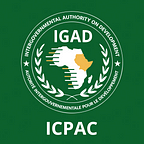Extreme events hit the Global South the hardest, and threaten the food security of millions.
By Alexander Müller and Guleid Artan
Extreme events borne of the climate crisis have risen at an alarmingly pace in recent times. Drought and heat stress afflict most continents, floods are submerging large parts of South Sudan and Pakistan and, in the past three years, desert locusts have ravaged Eastern Africa.
At just 1.2°C — the current rate of global warming — we are already witnessing the destruction of climate change. Never before has the need for early warning-early action systems been so pressing.
A recent analysis of the scientific linkages between climate change and pest and disease outbreaks by TMG Think Tank for Sustainability (TMG) and Igad’s Climate Prediction and Applications Centre (ICPAC) shows that extreme weather events produce cascading effects, including changing the dynamics of pest populations and expansion.
For instance, abnormal cyclonic activity in arid areas can spur destructive pest outbreaks such as desert locusts. Aphids show increasing potential for migration and dispersal owing to winds and warmer winters, while heatwaves have fuelled wildfires and the decimation of food crops.
Ultimately, these extreme events hit the Global South the hardest, and threaten the food security of millions of people. Yet, today we are rich in new technologies that can predict most natural hazards, which go hand-in-hand with the design and operation of modern early warning systems. Artificial intelligence (AI) tools can improve our predictive capabilities enormously.
By utilising data from satellites and monitoring the planet’s edaphology (especially soil moisture), scientists can look far into the future.
Take the example of droughts, the most destructive natural disaster, since they can endure for years — the Horn of Africa is about to experience its fifth consecutive failed rain season. Many variables govern drought occurrence and duration, including the interfaces between the atmosphere, ocean circulation, land, and their interactions.
These dynamics are too intricate to be captured by traditional computational models. But, with Big Data from satellite imagery, algorithms can untangle this complexity and generate robust predictions of drought, up to 12 months ahead.
Research by TMG and ICPAC also reveals that AI can excel in the prediction of desert locust outbreaks — perhaps the gravest of all transboundary pest threats. Scientists use AI to analyse edaphic variables such as soil texture and moisture (again, measured through satellites) and predict locust breeding grounds up to 70 days in advance with 90 percent probability.
In the absence of effective early warning-early action systems, the world will be increasingly confronted with catastrophes. Clearly, the benefits of early warning systems are manifold.
But, for the systems to succeed, they will need to be cast within a framework of an adaptive and responsive governance model. Climate emergency transcends borders and requires intergovernmental co-ordination and collaboration. Only by working together can we adapt to this crisis.
Alexander Müller is Managing Director, TMG Think Tank for Sustainability, Berlin, and Guleid Artan is Director, ICPAC, Nairobi
This article was originally published on The East African newspaper, October 15 — October 21, 2022 edition.
